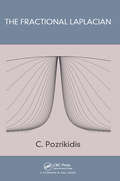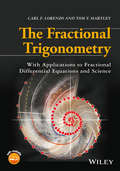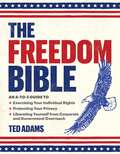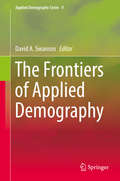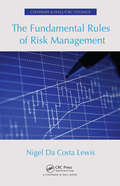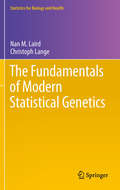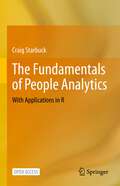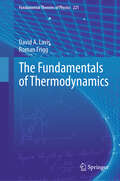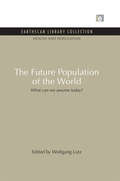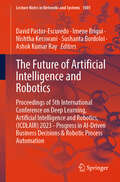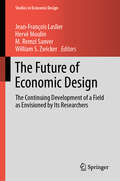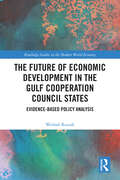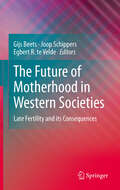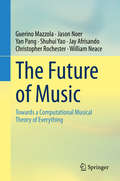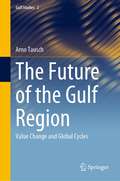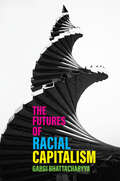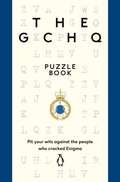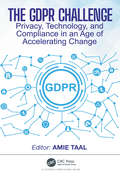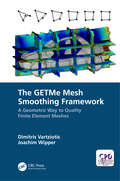- Table View
- List View
The Fractal Geometry Of Nature
by Benoit MandelbrotExplore the wondrously complex repeating shapes of the natural world in The Fractal Geometry of Nature. Written in a style that is accessible to a wide audience, computer scientist, professor, mathematician, economist, and visionary Benoit B Mandelbrot's fascinating work has inspired popular interest in the geometry inherent in the natural world. Unlike the squares, circles, spheres, and cones of fundamental geometry, nature has rough edges and no straight lines or perfect curves. Mandelbrot observed that, even with this roughness, there still exists a kind of symmetry, which he dedicated his work to document and study. This became the basis for his development of a new kind of geometry; indeed, he coined the term "fractal."
The Fractalist
by Benoit MandelbrotA fascinating memoir from the man who revitalized visual geometry, and whose ideas about fractals have changed how we look at both the natural world and the financial world.Benoit Mandelbrot, the creator of fractal geometry, has significantly improved our understanding of, among other things, financial variability and erratic physical phenomena. In The Fractalist, Mandelbrot recounts the high points of his life with exuberance and an eloquent fluency, deepening our understanding of the evolution of his extraordinary mind. We begin with his early years: born in Warsaw in 1924 to a Lithuanian Jewish family, Mandelbrot moved with his family to Paris in the 1930s, where he was mentored by an eminent mathematician uncle. During World War II, as he stayed barely one step ahead of the Nazis until France was liberated, he studied geometry on his own and dreamed of using it to solve fresh, real-world problems. We observe his unusually broad education in Europe, and later at Caltech, Princeton, and MIT. We learn about his thirty-five-year affiliation with IBM's Thomas J. Watson Research Center and his association with Harvard and Yale. An outsider to mainstream scientific research, he managed to do what others had thought impossible: develop a new geometry that combines revelatory beauty with a radical way of unfolding formerly hidden laws governing utter roughness, turbulence, and chaos. Here is a remarkable story of both the man's life and his unparalleled contributions to science, mathematics, and the arts.
The Fractional Laplacian
by C. PozrikidisThe fractional Laplacian, also called the Riesz fractional derivative, describes an unusual diffusion process associated with random excursions. The Fractional Laplacian explores applications of the fractional Laplacian in science, engineering, and other areas where long-range interactions and conceptual or physical particle jumps resulting in an irregular diffusive or conductive flux are encountered. Presents the material at a level suitable for a broad audience of scientists and engineers with rudimentary background in ordinary differential equations and integral calculus Clarifies the concept of the fractional Laplacian for functions in one, two, three, or an arbitrary number of dimensions defined over the entire space, satisfying periodicity conditions, or restricted to a finite domain Covers physical and mathematical concepts as well as detailed mathematical derivations Develops a numerical framework for solving differential equations involving the fractional Laplacian and presents specific algorithms accompanied by numerical results in one, two, and three dimensions Discusses viscous flow and physical examples from scientific and engineering disciplines Written by a prolific author well known for his contributions in fluid mechanics, biomechanics, applied mathematics, scientific computing, and computer science, the book emphasizes fundamental ideas and practical numerical computation. It includes original material and novel numerical methods.
The Fractional Trigonometry: With Applications to Fractional Differential Equations and Science
by Tom T. Hartley Carl F. LorenzoAddresses the rapidly growing field of fractional calculus and provides simplified solutions for linear commensurate-order fractional differential equations The Fractional Trigonometry: With Applications to Fractional Differential Equations and Science is the result of the authors' work in fractional calculus, and more particularly, in functions for the solutions of fractional differential equations, which is fostered in the behavior of generalized exponential functions. The authors discuss how fractional trigonometry plays a role analogous to the classical trigonometry for the fractional calculus by providing solutions to linear fractional differential equations. The book begins with an introductory chapter that offers insight into the fundamentals of fractional calculus, and topical coverage is then organized in two main parts. Part One develops the definitions and theories of fractional exponentials and fractional trigonometry. Part Two provides insight into various areas of potential application within the sciences. The fractional exponential function via the fundamental fractional differential equation, the generalized exponential function, and R-function relationships are discussed in addition to the fractional hyperboletry, the R1-fractional trigonometry, the R2-fractional trigonometry, and the R3-trigonometric functions. The Fractional Trigonometry: With Applications to Fractional Differential Equations and Science also: Presents fractional trigonometry as a tool for scientists and engineers and discusses how to apply fractional-order methods to the current toolbox of mathematical modelers Employs a mathematically clear presentation in an e ort to make the topic broadly accessible Includes solutions to linear fractional differential equations and generously features graphical forms of functions to help readers visualize the presented concepts Provides effective and efficient methods to describe complex structures The Fractional Trigonometry: With Applications to Fractional Differential Equations and Science is an ideal reference for academic researchers, research engineers, research scientists, mathematicians, physicists, biologists, and chemists who need to apply new fractional calculus methods to a variety of disciplines. The book is also appropriate as a textbook for graduate- and PhD-level courses in fractional calculus. Carl F. Lorenzo is Distinguished Research Associate at the NASA Glenn Research Center in Cleveland, Ohio. His past positions include chief engineer of the Instrumentation and Controls Division and chief of the Advanced Controls Technology and Systems Dynamics branches at NASA. He is internationally recognized for his work in the development and application of the fractional calculus and fractional trigonometry. Tom T. Hartley, PhD, is Emeritus Professor in the Department of Electrical and Computer Engineering at The University of Akron. Dr Hartley is a recognized expert in fractional-order systems, and together with Carl Lorenzo, has solved fundamental problems in the area including Riemann's complementary-function initialization function problem. He received his PhD in Electrical Engineering from Vanderbilt University.
The Freedom Bible: An A-to-Z Guide to Exercising Your Individual Rights, Protecting Your Privacy, Liberating Yourself from Corporate and Government Overreach
by Ted AdamsLearn How to Protect Your Family&’s Freedom!Freedom is the foundation on which America was born and continues to thrive. If you believe in the strength of freedom as more than an ideal, you can find smart ways to exercise it in all parts of your life! The Freedom Bible is your A-to-Z guide to knowing your individual rights and seeking more control and freedom through the decisions you face every day.Own healthcare decisions for you and your familyMake choices that direct your dollars where you want—for example, made in America, not overseasKnow your options to challenge governing boards—from home ownership associations to school boardsReduce your reliance on &“the grid&”Escape the invasiveness of all kinds of technologyGuard your privacy and free speech on social mediaAnd much more!Get freedom from…· Big Government· Big Tech· Dependence on Overseas Goods· Employer &“Requirements&”· HOAs· Social media jail· Spam callers· Taxes· And More!
The Friction of Life: An investigation on Renato Caccioppoli's life
by Lorenza FoschiniNaples, May 8, 1959. Renato Caccioppoli, a mathematical genius, prodigious pianist, captivating storyteller, highly cultured and multilingual, believed to be the grandson of the anarchist movement founder Mikhail Bakunin, takes his own life by shooting himself in the back of the head in his residence at Palazzo Cellammare.Adored by students and colleagues, a symbol of freedom and non-conformity for an entire generation, Caccioppoli enchanted not only some of the most celebrated intellectuals of the century – André Gide, Pablo Neruda, Eduardo De Filippo, Benedetto Croce, Alberto Moravia, Elsa Morante – but also, and above all, the people of Naples, who have always regarded him with amazed admiration. Persecuted by the fascist regime, afflicted by what the writer and friend Paola Masino would describe as "the friction of life," his death permanently places him in the city's history.This meticulous and well-documented investigation tells us who Caccioppoli truly was and offers us an un-stereotyped and, in some ways, unprecedented portrayal of a legendary Naples.
The Frontiers of Applied Demography
by David A. SwansonThis book details cutting-edge methods and findings that may shape the future of applied demography. Inside, readers will discover new insights into the databases, substantive issues, and methodological approaches that can help them to improve how they use demography in decision making and planning problems in both public and private settings. The topics and perspectives are found in the book's 23 chapters, which are organized into three major sections: (I) Demographic Information for Decision-Making: Case Studies; (II) Data: Issues and Analyses; and (III) Projection and Estimation Methods: Evaluations, Examples, and Discussions. Coverage includes chapters on migration, demographic market analysis, future courtroom needs, trends in the needs of the elderly, access to health care, longitudinal data systems, census costs, and new approaches to small area estimation and projection methods. The case studies represent a wide range of countries, including Australia, Canada, China, England, India, Japan, and the United States of America. Overall, this edited volume collects papers that were presented at different conferences, including the 8th international conference on population geographies (University of Queensland, 2015), the 2014 Applied Demography Conference (San Antonio, Texas, USA), and the annual conference of the Canadian Population Society. Applied demography touches many aspects of our lives and its practitioners continue to push methodological and empirical boundaries. This book documents the steady evolution of this field. It shows demographers, sociologists, economists, planners, marketers, and others how they can improve the quality and relevance of demographic information now and in the future.
The Fuglede-Putnam Theory (Lecture Notes in Mathematics #2322)
by Mohammed Hichem MortadThis book is essentially a survey of results on the Fuglede-Putnam theorem and its generalizations in a wide variety of directions. Presenting a broad overview of the results obtained in the field since the early 1950s, this is the first monograph to be dedicated to this powerful tool and its variants.Starting from historical notes and classical versions with their different proofs, the book then explores asymptotic versions, generalizations to non-normal operators, generalizations to unbounded operators, counterexamples, applications, intertwining relations, and conjectures. A rich collection of applications is included. Aimed at postgraduate students as well as researchers interested in operator theory, this book could also be taught as a specialized course.
The Fundamental Rules of Risk Management
by Nigel LewisThe consequences of taking on risk can be ruinous to personal finances, professional careers, corporate survivability, and even nation states. Yet many risk managers do not have a clear understanding of the basics. Requiring no statistical or mathematical background, The Fundamental Rules of Risk Management gives you the knowledge to successfully h
The Fundamentals of Atomic and Molecular Physics
by Robert L BrooksThe Fundamentals of Atomic and Molecular Physics is intended as an introduction to the field for advanced undergraduates who have taken quantum mechanics. Each chapter builds upon the previous, using the same tools and methods throughout. As the students progress through the book, their ability to use these tools will steadily increase, along with their confidence in their efficacy. The book treats the two-electron atom as the simplest example of the many-electron atom--as opposed to using techniques that are not applicable to many-electron atoms--so that it is unnecessary to develop additional equations when turning to multielectron atoms, such as carbon. External fields are treated using both perturbation theory and direct diagonalization and spontaneous emission is developed from first principles. Only diatomic molecules are considered with the hydrogen molecular ion and neutral molecule treated in some detail. This comprehensive coverage of the quantum mechanics of complex atoms and simple diatomic molecules, developed from the very basic components, is extremely useful for students considering graduate studies in any area of physics.
The Fundamentals of Modern Statistical Genetics
by Nan M. Laird Christoph LangeThis book covers the statistical models and methods that are used to understand human genetics, following the historical and recent developments of human genetics. Starting with Mendel's first experiments to genome-wide association studies, the book describes how genetic information can be incorporated into statistical models to discover disease genes. All commonly used approaches in statistical genetics (e.g. aggregation analysis, segregation, linkage analysis, etc), are used, but the focus of the book is modern approaches to association analysis. Numerous examples illustrate key points throughout the text, both of Mendelian and complex genetic disorders. The intended audience is statisticians, biostatisticians, epidemiologists and quantitatively- oriented geneticists and health scientists wanting to learn about statistical methods for genetic analysis, whether to better analyze genetic data, or to pursue research in methodology. A background in intermediate level statistical methods is required. The authors include few mathematical derivations, and the exercises provide problems for students with a broad range of skill levels. No background in genetics is assumed.
The Fundamentals of People Analytics: With Applications in R
by Craig StarbuckThis open access book prepares current and aspiring analytics professionals to effectively address this need by curating key concepts spanning the entire analytics lifecycle, along with step-by-step instructions for their applications to real-world problems, using ubiquitous and freely available open-source software. This book does not assume prior knowledge of statistics, how to query databases, or how to write performant code; early chapters include an introduction to R and SQL as well as an overview of statistical foundations.Human capital is an organization’s most important asset. Without the knowledge and skills of people, an organization can accomplish nothing. The acquisition, development, and retention of critical talent has become increasingly more complex and challenging, and organizations are making significant investments to gain a deeper, data-informed understanding of organizational phenomena impacting the bottom line. By the end of this book, readers will be able to: • Design and conduct empirical research • Query and wrangle data using SQL • Profile, clean, and analyze data using R • Apply appropriate statistical and ML models to a range of people analytics use cases • Package and present analyses to communicate impactful insights to stakeholders
The Fundamentals of Thermodynamics (Fundamental Theories of Physics #221)
by Roman Frigg David A. LavisThe aim of this text is to provide an account of the fundamentals of thermodynamics which is accessible at graduate level to physicists, mathematicians and philosophers of physics. The bulk of the book (Chapters 2-9) is based on the algebraic approach of Lieb and Yngvason, but extended to encompass both positive and negative temperatures and systems in which entropy increases and decreases in adiabatic processes. We show that these four possibilities are already present in Carathéodory's version of the Second Law which arises as a theorem from the axioms. We develop generalized versions of the Kelvin-Planck and Clausius formulations valid for the same range of systems. The parallel development in Chapter 10 takes a geometric approach. We discuss the limitations associated with the local nature of Carathéodory's Principle and present the resolution of this problem due to Boyling. Part of the aim here is to substantiate the claim of Arnold that the mathematical structure of thermodynamics is contact geometry. The last two chapters of the book extend the scope of the discussion to, respectively, critical phenomena and non-equilibrium systems. Chapter 11 is a presentation of phase transitions and critical phenomena in which we discuss universality and use scaling theory to derive scaling laws. Chapter 12 contains a generalization to non-equilibrium. We present the extension of Lieb and Yngvason's work to non-equilibrium and also give a brief account of classical irreversible thermodynamics (CIT). The latter enables a possible understanding of the way that the lack of a unique entropy function in the Lieb and Yngvason non-equilibrium approach can be resolved. The book is completed by a set of appendices which provide mathematical and physical support to the work in the main text.
The Future Population of the World: What can we assume today (Health and Population Set)
by Wolfgang LutzThe highly acclaimed The Future Population of the World contains the most authoritative assessment available of the extent to which population is likely to grow over the next 50 to 100 years. The book provides a thorough analysis of all the components of population change and translates these factors into a series of projections for the population of the world's regions. This revised and updated version incorporates completely new scenario projections based on updating starting values and revised assumptions, plus several methodological improvements. It also contains the best currently available information on global trends in AIDS mortality and the first ever fully probabilistic world population projections. The projections, given up to 2100, add important additional features to those of the UN and the World Bank: they show the impacts of alternative assumptions for all three components (mortality and migration, as well as fertility); they explicitly take into account possible environmental limits to growth; and, for the first time, they define confidence levels for global populations. Combining methodological innovation with overviews of the most recent data and literature, this updated edition of The Future Population of the World is sure to conform its reputation as the most comprehensive and essential publication in the field.
The Future of Artificial Intelligence and Robotics: Proceedings of 5th International Conference on Deep Learning, Artificial Intelligence and Robotics, (ICDLAIR) 2023 - Progress in AI-Driven Business Decisions & Robotic Process Automation (Lecture Notes in Networks and Systems #1001)
by Nishtha Kesswani Imene Brigui David Pastor-Escuredo Sushanta Bordoloi Ashok Kumar RayThis book includes the results from the 5th International Conference on Deep Learning, Artificial Intelligence and Robotics (ICDLAIR), held in National Institute of Technology, Kurukshetra, on December 07–09, 2023, which brought together visionaries, researchers, and industry leaders at the forefront of technological innovation. In the rapidly evolving landscape of technology, deep learning, artificial intelligence, and robotics stand as a beacon of innovation and intellectual exchange. Among the myriad of groundbreaking contributions, a notable gem emerges—a forthcoming book that promises to encapsulate the essence of the 5th International Conference on Deep Learning, Artificial Intelligence and Robotics, (ICDLAIR) 2023 proceedings. Titled " Progress in AI-Driven Business Decisions & Robotic Process Automation," this publication is poised to become a cornerstone for enthusiasts, researchers, and professionals seeking a comprehensive understanding of the latest advancements in deep learning, artificial intelligence, and robotics. Focused on the theme "Progress in AI-Driven Business Decisions & Robotic Process Automation," the conference showcased groundbreaking developments in the field, exploring the intersection of deep learning, artificial intelligence (AI), and robotics.
The Future of Economic Design: The Continuing Development of a Field as Envisioned by Its Researchers (Studies in Economic Design)
by Jean-François Laslier Hervé Moulin M. Remzi Sanver William S. ZwickerThis collection of essays represents responses by over eighty scholars to an unusual request: give your high level assessment of the field of economic design, as broadly construed. Where do we come from? Where do we go from here? The book editors invited short, informal reflections expressing deeply felt but hard to demonstrate opinions, unsupported speculation, and controversial views of a kind one might not normally risk submitting for review. The contributors – both senior researchers who have shaped the field and promising, younger researchers – responded with a diverse collection of provocative pieces, including: retrospective assessments or surveys of the field; opinion papers; reflections on critical points for the development of the discipline; proposals for the immediate future; "science fiction"; and many more. The readers should have fun reading these unusual pieces – as much as the contributors enjoyed writing them.
The Future of Economic Development in the Gulf Cooperation Council States: Evidence-Based Policy Analysis (Routledge Studies in the Modern World Economy)
by Weshah RazzakThe Gulf Cooperation Council (GCC) countries own 30 percent of the world’s proven oil reserves and largely depend on oil for their income. Yet, the GCC faces serious challenges. The global demand for oil is expected to continue declining and the average long-run oil price could become lower than its historical average in the future. This book is a research–based, structural macroeconomic analysis, providing evidence-based and future-facing, policy recommendations for GCC governments. First, it analyzes historical data to explain the macroeconomic performance and economic policies of the GCC countries from 1970 to 2019. Then it presents ten-year dynamic stochastic projections from 2020 to 2030. The book examines debt sustainability and optimal fiscal policies, i.e., government spending and taxation. It also analyses structural issues such as savings and productivity, and from an institutional perspective, taking into account education, the labor market, and pension funds, as well as other factors that have a close effect on economic performance. The book is comprehensive and thorough, it relies on extensive econometric analyses, including rigorous time series analysis. The author uses both calibration of theoretical models and estimation, facilitating projections for the next decade of key economic variables under different policy scenarios. The book also assesses what the future of the GCC economies will look like if climate change and the COVID-19 pandemic continue to, adversely, affect oil supply and demand, and the price of oil, given their current policies and institutions. As well as scholars and researchers of economics and finance, the book will engage policymakers in central banks, treasury departments, planning councils, research institutes and think tanks.
The Future of Motherhood in Western Societies
by Egbert R. te Velde Gijs Beets Joop SchippersMost people value to have children still highly. But what is the optimal moment to have the first? The decision on having children or not and if yes on the timing of the first is one of the most difficult ones to make, also because it more or less coincides with various other heavy decisions on shaping the life course (like on union formation, labour market career, housing accommodation, etc.). People realise that having children will fundamentally change their life and in order to fit this unknown and irreversible adventure perfectly into their life course postponement of the first birth is an easy way out as long as doubts continue and partners try to make up their mind. Modern methods of birth control are of course a very effective help in that period. What is the best moment to have the first child? And to what moment is postponement justified? There are no easy answers to these questions. Best solutions vary per person as they depend on personal circumstances and considerations (the partner may have conflicting ideas; housing accommodation; job; income; free time activities). Existing parental leave and child care arrangements are weighted as well. Unfortunately the biological clock ticks further. And, also unfortunately, assisted reproductive technology (IVF etc.) is unable to guarantee a successful outcome. Several couples end up without children involuntarily and that may lead to sorrow and grief. This interdisciplinary book overviews the process of postponement and its backgrounds in modern Western societies holistically, both at the personal and the societal level. Contributions come from reproductive, evolutionary biological and neurological sciences, as well as from demography, economy, sociology and psychology. It holds not only at women but also at men becoming first time fathers. The discussion boils down to a new policy approach for motherhood and emancipation on how to shape work and family life? It is argued that a public window where one can compose a 'cafeteria'-like set of supportive arrangements according to personal preferences could lead to a break in the rising age at first motherhood.
The Future of Music: Towards a Computational Musical Theory of Everything
by Guerino Mazzola Yan Pang Jason Noer Shuhui Yao Jay Afrisando Christopher Rochester William NeaceThe idea of this monograph is to present an overview of decisive theoretical, computational, technological, aesthetical, artistic, economical, and sociological directions to create future music. It features a unique insight into dominant scientific and artistic new directions, which are guaranteed by the authors' prominent publications in books, software, musical, and dance productions.Applying recent research results from mathematical and computational music theory and software as well as new ideas of embodiment approaches and non-Western music cultures, this book presents new composition methods and technologies. Mathematical, computational, and semiotic models of artistic presence (imaginary time, gestural creativity) as well as strategies are also covered.This book will be of interest to composers, music technicians, and organizers in the internet-based music industry, who are offered concrete conceptual architectures and tools for their future strategies in musical creativity and production.
The Future of the Gulf Region: Value Change and Global Cycles (Gulf Studies #2)
by Arno TauschThis book studies values and attitudes in the Gulf region. In light of global power shifts, the threatening collapse of internal security in the West, and uncertainty about the current leadership vacuum in world society, this book explores a future leading role of the Gulf countries in such institutions as the G-20 and the OECD. Based on rigorous analysis of macro-level data and opinion surveys with relevance for the Gulf region, it analyzes the global macro-factors shaping the Gulf's future at a time of the global COVID-19 crisis and depression and rising global tensions. Starting with an empirical time series analysis of the long cycles of global politics and economics, it highlights the implications for the Gulf region. Offering a multivariate analysis of civil society values in the Gulf, the author analyzes value changes and attitudes on antisemitism, political Islam, internal security, democracy, and other issues of Arab politics. The partially optimistic conclusions of the study testify to the underestimated and incipient maturity of the Gulf’s civil society and strongly suggest that the Gulf's future is rather with the free societies of the West and not with a Neo-Ottoman Empire in whatever form."Exceptional in scope and right up-to-the-minute in coverage"Brian M Pollins, Associate, Professor Emeritus, The Ohio State University."An outstanding and topical book by an astute scholar of the MENA region"Professor Hussein Solomon, Academic Head of Department, Political Studies and Governance, University of the Free State, South Africa."The most comprehensive and insightful study on the subject to date"Manfred B. Steger, Professor of Sociology, University of Hawai'i at Manoa and Global Professorial Fellow, Western Sydney University.
The Futures of Racial Capitalism
by Gargi BhattacharyyaCapitalism appears to be endlessly in crisis but without ever loosening its hold on our lives. New modes of racism and exclusion emerge, but the old ones never go away. We continue to struggle to live and survive in its wake but are unable, still now, to build commonality with each other. In this incisive book, Gargi Bhattacharyya revisits debates about racial capitalism and its violence through differentiation. Taking the four lenses of prisons, borders, debt and platforms, Bhattacharyya reveals how this moment of capitalist crisis positions humans as expendable, but differentially so, in a process that remakes longstanding racialized hierarchies. Uncovering practices and techniques embedded in the shifting processes of accumulation and state power, the chapters illuminate how value is extracted from populations through non-wage routes and indebtedness. This engaging introduction to racial capitalism offers an interlocking and insightful analysis of capitalist renewal, essential for students and scholars interested in issues of race, racism and inequality.
The GCHQ Puzzle Book II
by GCHQTrain your brain with these fiendishly difficult puzzles, the perfect companion for anyone wanting to keep their mind busy'Fiendishly tricky' Daily MailWith their first bestselling book, The GCHQ Puzzle Book, the UK's intelligence and security experts tested us with puzzles, codes and real-life entrance tests from their archives.Now, they are back with a NEW collection of head-scratching, mind-boggling and brain-bending puzzles that will leave you pondering for hours.For those who often found themselves stumped with the first book, The GCHQ Puzzle Book 2 offers even more starter puzzles to get those brains warmed up. Puzzle aficionados needn't worry though, as there is also an 'Even Harder' section to test everyone to their limits . . .Not only that, but in celebration of GCHQ's centenary, the puzzles in this new book sit alongside stories, facts and photos from the organisation's first 100 years at the heart of the nation's security. From the Government Code & Cipher School, to Bletchley Park, through to protecting against cyberattacks, the security of our country is in the hands of GCHQ. With this book, you get exclusive snapshots into the organisation that keeps us all safe.Train your brain to compete with the smartest in the country with this stimulating book of puzzles. If you haven't yet tested yourself with the first instalment of The GCHQ Puzzle Book, check it out now!'This is the perfect gift to fuel his ludicrous presumption that he could have definitely been a spy - even better if he's already dog-eared the first version' Huffington Post
The GCHQ Puzzle Book: Perfect for anyone who likes a good headscratcher
by GCHQSharpen your mind to beat the smartest brains in Britain with the original official GCHQ puzzle bookWould GCHQ recruit you? Pit your wits against the people who cracked Enigma in the official puzzle book from Britain's top secret intelligence and security organisationOver the years, their codebreakers have helped keep our country safe, from the Bletchley Park breakthroughs of WWII to the modern-day threat of cyber attack. So it comes as no surprise that, even in their time off, the staff at GCHQ love a good puzzle.Whether they're recruiting new staff or challenging each other to the toughest Christmas quizzes and treasure hunts imaginable, puzzles are at the heart of what GCHQ does. Now they're opening up their archives of decades' worth of codes, puzzles and challenges for everyone to try.In this book you will find:- Tips on how to get into the mindset of a codebreaker- Puzzles ranging in difficulty from easy to brain-bending- A competition section where we search for Britain's smartest puzzlerWith hundreds of stimulating puzzles, The GCHQ Puzzle Book is the perfect companion and will keep you occupied as you attempt to beat the smartest brains in Britain.GOOD LUCK!'Fiendish . . . as frustrating, divisive and annoying as it is deeply fulfilling' Guardian'Ideal for the crossword enthusiast' Daily TelegraphLooking for more ways to test yourself? The GCHQ Puzzle Book 2, a new collection of head-scratching, mind-boggling and brain-bending puzzles is out now!
The GDPR Challenge: Privacy, Technology, and Compliance in an Age of Accelerating Change
by Amie TaalConsent is necessary for collecting, processing and transferring Personal Identifiable Information (PII) and sensitive personal data. But to what extent? What are the limitations and restricts to avoid penalties under The General Data Protection Regulation 2018 (GDPR) rules, which may be up to 4% of annual global turnover or €20 million (whichever is higher), enforcements and sanctions? Under GDPR Article 51, each EU Member State shall maintain an independent public authority to be responsible for monitoring the application of this regulation to protect the fundamental rights of data subjects (Supervisory Authority). The Supervisory Authority has powers to issue warnings, conduct audits, recommend remediation, order erasure of data and suspend data transfers to a third country.GDPR has changed the way data is used, accessed and stored. It's reach extends well beyond the European Union and is the basis of other data privacy laws around the world.This book provides a review and guidance on implementing and compliance of GDPR while taking advantage of technology innovations and supported by real-life examples. The book shows the wide scope of applications to protect data privacy while taking advantage of processes and techniques in various fields such as eDiscovery, Cyber Insurance, Virtual-based Intelligence, Information Security, Cyber Security, Information Governance, Blockchain and Biometric technologies and techniques.
The GETMe Mesh Smoothing Framework: A Geometric Way to Quality Finite Element Meshes
by Joachim Wipper Dimitris VartziotisHigh quality meshes play a key role in many applications based on digital modeling and simulation. The finite element method is a paragon for such an approach and it is well known that quality meshes can significantly improve computational efficiency and solution accuracy of this method. Therefore, a lot of effort has been put in methods for improving mesh quality. These range from simple geometric approaches, like Laplacian smoothing, with a high computational efficiency but possible low resulting mesh quality, to global optimization-based methods, resulting in an excellent mesh quality at the cost of an increased computational and implementational complexity. <P><P>The geometric element transformation method (GETMe) aims to fill the gap between these two approaches. It is based on geometric mesh element transformations, which iteratively transform polygonal and polyhedral elements into their regular counterparts or into elements with a prescribed shape. GETMe combines a Laplacian smoothing-like computational efficiency with a global optimization-like effectiveness. The method is straightforward to implement and its variants can also be used to improve tangled and anisotropic meshes. <P><P>This book describes the mathematical theory of geometric element transformations as foundation for mesh smoothing. It gives a thorough introduction to GETMe-based mesh smoothing and its algorithms providing a framework to focus on effectively improving key mesh quality aspects. It addresses the improvement of planar, surface, volumetric, mixed, isotropic, and anisotropic meshes and addresses aspects of combining mesh smoothing with topological mesh modification. <P><P>The advantages of GETMe-based mesh smoothing are demonstrated by the example of various numerical tests. These include smoothing of real world meshes from engineering applications as well as smoothing of synthetic meshes for demonstrating key aspects of GETMe-based mesh improvement. Results are compared with those of other smoothing methods in terms of runtime behavior, mesh quality, and resulting finite element solution efficiency and accuracy. <P><P>Features: <li>Helps to improve finite element mesh quality by applying geometry-driven mesh smoothing approaches. <li>Supports the reader in understanding and implementing GETMe-based mesh smoothing. <li>Discusses aspects and properties of GETMe smoothing variants and thus provides guidance for choosing the appropriate mesh improvement algorithm. <li>Addresses smoothing of various mesh types: planar, surface, volumetric, isotropic, anisotropic, non-mixed, and mixed. <li>Provides and analyzes geometric element transformations for polygonal and polyhedral elements with regular and non-regular limits. <li>Includes a broad range of numerical examples and compares results with those of other smoothing methods.


